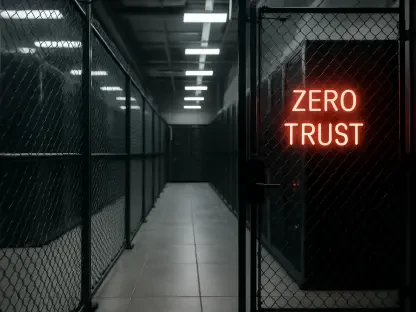Unveiling the AI Security Challenge in Today’s Market
In an era where Artificial Intelligence (AI) drives business transformation, a staggering projection from Statista reveals that the global AI market is set to surpass $1 trillion by 2031, growing at a compound annual rate of 26.6%. This explosive growth underscores a pressing concern: as companies across industries rush to adopt AI, are their network security systems equipped to handle the unique threats this technology introduces? The rapid integration of AI into corporate operations has opened new vulnerabilities, making it imperative to analyze how the market is responding to these risks. This analysis delves into the evolving landscape of network security in the face of AI-driven challenges, exploring current trends, data-driven insights, and future projections. By examining the intersection of innovation and protection, the goal is to provide a comprehensive understanding of how businesses can safeguard their digital assets in this dynamic environment.
Market Trends: The Collision of AI Growth and Security Needs
AI Adoption Driving Security Investments
The market for AI technologies is witnessing unprecedented expansion, with industries ranging from finance to healthcare embedding these tools into their core operations. This surge has catalyzed a parallel increase in demand for advanced network security solutions tailored to AI-specific risks. Recent data indicates that cybersecurity spending is projected to rise significantly from 2025 to 2027, as companies recognize the inadequacy of traditional defenses against sophisticated AI-targeted attacks. Unlike past threats like malware or phishing, AI vulnerabilities require specialized approaches, pushing vendors to innovate rapidly. This trend highlights a shift in market dynamics, where security providers are racing to develop tools that can anticipate and neutralize threats before they exploit AI systems.
Evolving Threat Landscape and Market Responses
As AI becomes more pervasive, the threat landscape is evolving with alarming speed, creating new challenges for network security providers. Bad actors are increasingly targeting AI resources directly, exploiting vulnerabilities such as prompt manipulations and data tampering. Market analysis shows a sharp rise in AI-specific attacks, with incidents of digital deception like deepfakes increasing by over 300% in recent years, according to Surfshark data. This escalation has prompted security firms to pivot toward hybrid models that blend conventional tools with AI-focused defenses. The market is also seeing a growing emphasis on proactive strategies, such as adversarial testing, as businesses seek to stay ahead of perpetrators in an increasingly complex digital arena.
Regulatory and Compliance Pressures Shaping the Sector
Another critical trend shaping the network security market is the emergence of regulatory frameworks aimed at addressing AI-related risks. Governments worldwide are beginning to draft mandates that could redefine compliance standards for companies leveraging AI technologies. This regulatory push is influencing market behavior, with security vendors expanding their offerings to include compliance management tools tailored to these evolving requirements. For industries handling sensitive data, such as healthcare and finance, adherence to standards like HIPAA and SOC 2 remains a priority, but the integration of AI introduces additional layers of complexity. Market projections suggest that compliance-driven solutions will become a significant growth area for security providers in the coming years.
In-Depth Analysis: Key AI Threats Impacting Network Security
Prompt Exploitation: A Vulnerability in AI Interactions
A prominent concern in the market is the exploitation of AI prompts and chat systems, which serve as entry points for attackers seeking sensitive information. High-profile incidents, such as a user manipulating a dealership chatbot to secure a $76,000 vehicle for just $1 in 2023, illustrate the financial risks at stake. These vulnerabilities have led to a growing market for solutions that focus on securing AI interactions through rigorous testing and patch management. Security providers are increasingly collaborating with application developers to create defenses against adversarial prompts, reflecting a broader trend of cross-functional innovation in the industry. The market response indicates a clear need for tools that balance AI accessibility with robust protection mechanisms.
Data Integrity Risks: The Threat of Poisoning and Bias
Data poisoning and model bias represent another critical area of concern, as attackers manipulate AI training data to skew results and mislead decision-making processes. This threat has significant implications for industries reliant on accurate AI outputs, such as financial forecasting and medical diagnostics. Network security providers are stepping up by offering solutions that secure data repositories and monitor access points for unusual activity. Market analysis reveals a rising demand for forensic services in larger enterprises, where specialists investigate breaches and fortify defenses against such intrusions. This segment of the market is expected to grow as businesses prioritize maintaining the integrity of their AI systems to preserve trust and operational reliability.
Digital Deception: The Market Impact of Deepfakes
The proliferation of deepfakes has emerged as a major disruptor in the network security market, with fake communications being used for fraud and corporate impersonation. These attacks pose not only financial risks but also reputational damage, prompting a surge in demand for monitoring and tracing technologies. Security vendors are developing advanced analytics to detect anomalies in digital content, while also emphasizing employee training as a critical defense layer. Market insights suggest that the ability to identify and mitigate deepfake threats will become a competitive differentiator for security providers, as businesses seek comprehensive solutions to protect against this growing menace.
Future Projections: Navigating an AI-Driven Security Landscape
Looking ahead, the network security market is poised for significant transformation as AI continues to shape both opportunities and risks. Projections indicate that AI-targeted attacks will become more sophisticated, with perpetrators leveraging AI itself to automate and enhance their strategies. In response, the market for AI-driven security analytics is expected to expand, offering advanced threat detection capabilities but also introducing new vulnerabilities that vendors must address. Additionally, the integration of hybrid security models—combining traditional tools with specialized AI defenses—is forecasted to dominate the industry. This evolution suggests that agility and innovation will be key for security providers aiming to capture market share in this rapidly changing environment.
Reflecting on the Market Insights and Strategic Pathways
Looking back, this analysis illuminated the critical intersection of AI expansion and network security challenges, revealing how the market adapted to emerging threats through innovative solutions and regulatory alignment. The examination of trends such as prompt exploitation, data integrity risks, and deepfake proliferation underscored the urgent need for specialized defenses in a landscape transformed by AI. Moving forward, businesses must prioritize strategic investments in hybrid security models and proactive testing to stay ahead of evolving risks. Collaboration between security providers and application teams emerged as a vital step to ensure comprehensive protection. Ultimately, the path to securing AI-driven operations lies in fostering a culture of vigilance and adaptability, equipping companies to harness technological advancements while safeguarding their digital future.









